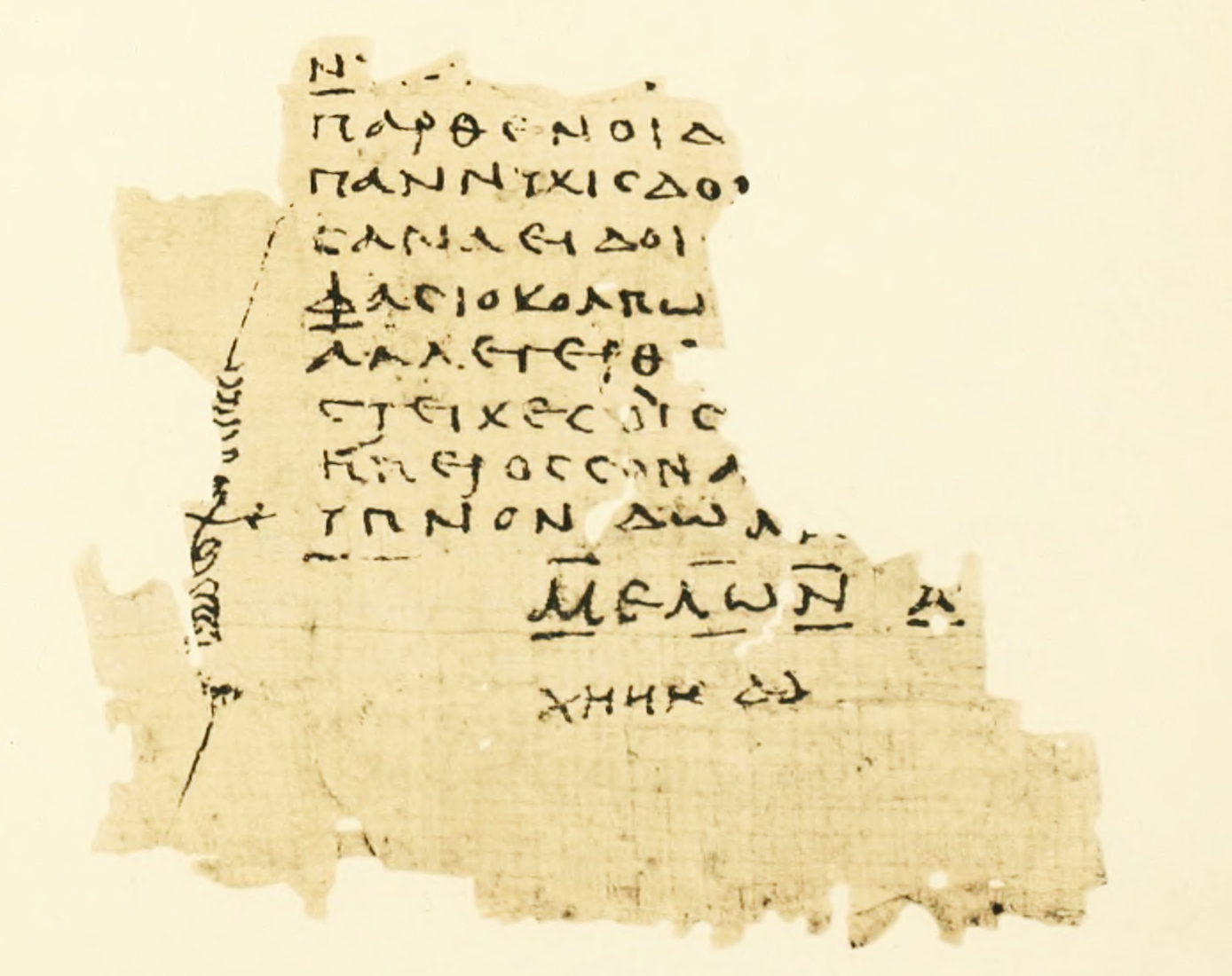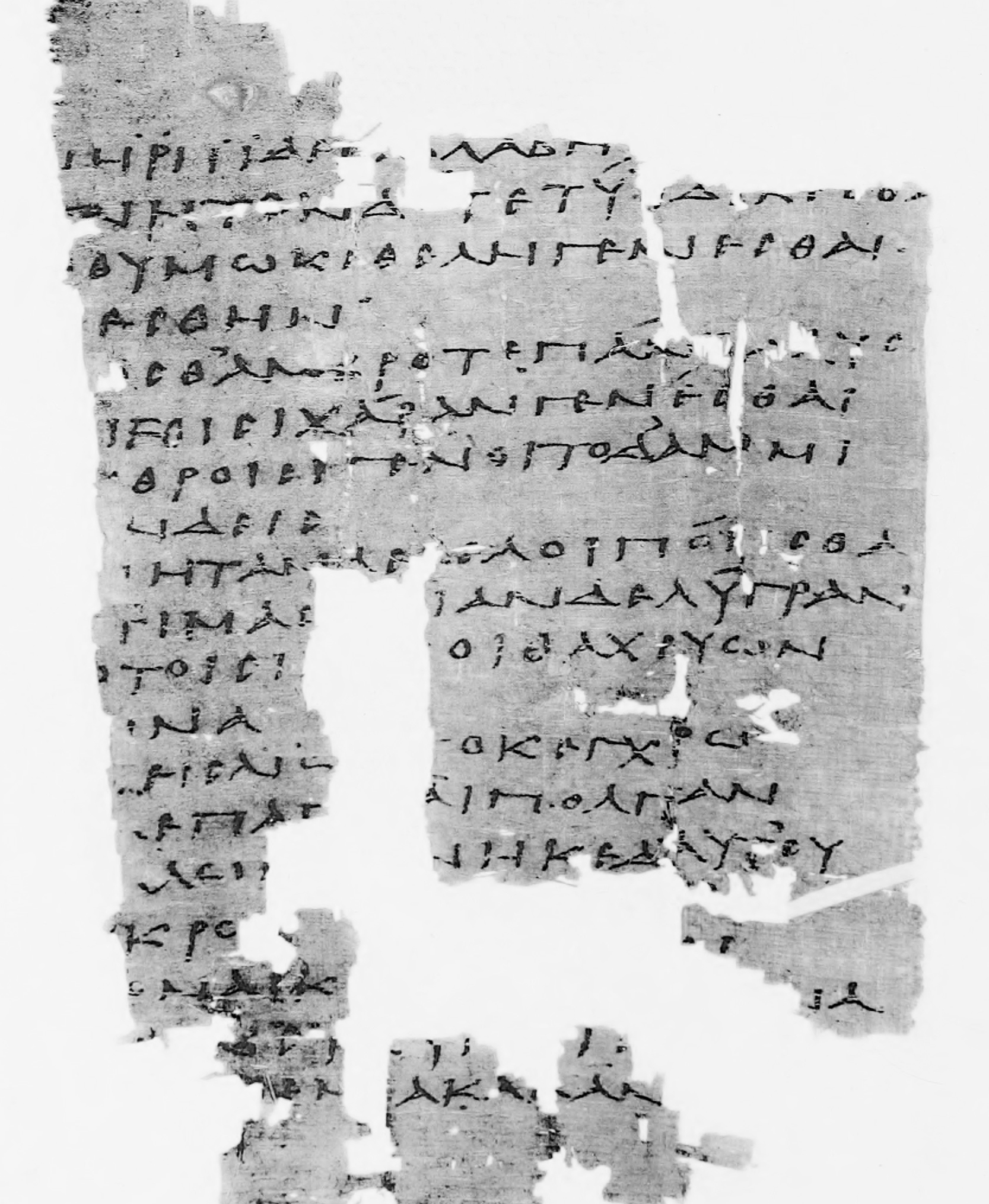|
Papyrus Oxyrhynchus 1231
Papyrus Oxyrhynchus 1231 (P. Oxy. 1231 or P. Oxy. X 1231) is a papyrus discovered at Oxyrhynchus in Egypt, first published in 1914 by Bernard Pyne Grenfell and Arthur Surridge Hunt. The papyrus preserves fragments of the second half of Book I of a Hellenistic edition of the poetry of the archaic poet Sappho. The papyrus comes from a second century AD roll, and is made up of 56 smaller fragments. The largest piece, fragment one, measures 17.7 cm × 13.2 cm; it covers two columns and includes fragments of four poems. It is written in a small informal upright hand, and corrections and marginalia have been added in a second hand, using a different ink. The papyrus preserves a number of fragments by Sappho. Fragment one of the papyrus preserves four consecutive fragments; frr. 15, 16, 17, and 18 in Voigt's edition. Also preserved, on fragment 56 of the papyrus, is the final poem of Book I of Sappho, fragment 30. A colophon at the end of fragment 56 of the papyrus s ... [...More Info...] [...Related Items...] OR: [Wikipedia] [Google] [Baidu] |
Oxyrhynchus
Oxyrhynchus (; grc-gre, Ὀξύρρυγχος, Oxýrrhynchos, sharp-nosed; ancient Egyptian ''Pr-Medjed''; cop, or , ''Pemdje''; ar, البهنسا, ''Al-Bahnasa'') is a city in Middle Egypt located about 160 km south-southwest of Cairo in Minya Governorate. It is also an archaeological site, considered one of the most important ever discovered. Since the late 19th century, the area around Oxyrhynchus has been excavated almost continually, yielding an enormous collection of papyrus texts dating from the Ptolemaic Kingdom and Roman Egypt. They also include a few vellum manuscripts, and more recent Arabic manuscripts on paper (for example, the medieval P. Oxy. VI 1006) History Ancient Egyptian Era Oxyrhynchus lies west of the main course of the Nile on the Bahr Yussef, a branch that terminates in Lake Moeris and the Faiyum oasis. In ancient Egyptian times, there was a city on the site called Per-Medjed, named after the medjed, a species of elephantfish of the ... [...More Info...] [...Related Items...] OR: [Wikipedia] [Google] [Baidu] |
Aeolic
In linguistics, Aeolic Greek (), also known as Aeolian (), Lesbian or Lesbic dialect, is the set of dialects of Ancient Greek spoken mainly in Boeotia; in Thessaly; in the Aegean island of Lesbos; and in the Greek colonies of Aeolis in Anatolia and adjoining islands. The Aeolic dialect shows many archaisms in comparison to the other Ancient Greek dialects (Arcadocypriot, Attic, Ionic, and Doric varieties), as well as many innovations. Aeolic Greek is widely known as the language of Sappho and of Alcaeus of Mytilene. Aeolic poetry, which is exemplified in the works of Sappho, mostly uses four classical meters known as the Aeolics: Glyconic (the most basic form of Aeolic line), hendecasyllabic verse, Sapphic stanza, and Alcaic stanza (the latter two are respectively named for Sappho and Alcaeus). In Plato's ''Protagoras'', Prodicus labelled the Aeolic dialect of Pittacus of Mytilene as "barbarian" (''barbaros''), because of its difference from the Attic literary style: ... [...More Info...] [...Related Items...] OR: [Wikipedia] [Google] [Baidu] |
Greek-language Papyri
Greek ( el, label=Modern Greek, Ελληνικά, Elliniká, ; grc, Ἑλληνική, Hellēnikḗ) is an independent branch of the Indo-European family of languages, native to Greece, Cyprus, southern Italy (Calabria and Salento), southern Albania, and other regions of the Balkans, the Black Sea coast, Asia Minor, and the Eastern Mediterranean. It has the longest documented history of any Indo-European language, spanning at least 3,400 years of written records. Its writing system is the Greek alphabet, which has been used for approximately 2,800 years; previously, Greek was recorded in writing systems such as Linear B and the Cypriot syllabary. The alphabet arose from the Phoenician script and was in turn the basis of the Latin, Cyrillic, Armenian, Coptic, Gothic, and many other writing systems. The Greek language holds a very important place in the history of the Western world. Beginning with the epics of Homer, ancient Greek literature includes many works of lasting imp ... [...More Info...] [...Related Items...] OR: [Wikipedia] [Google] [Baidu] |
Bodleian Library Collection
The Bodleian Library () is the main research library of the University of Oxford, and is one of the oldest libraries in Europe. It derives its name from its founder, Sir Thomas Bodley. With over 13 million printed items, it is the second-largest library in Britain after the British Library. Under the Legal Deposit Libraries Act 2003, it is one of six legal deposit libraries for works published in the United Kingdom, and under Irish law it is entitled to request a copy of each book published in the Republic of Ireland. Known to Oxford scholars as "Bodley" or "the Bod", it operates principally as a reference library and, in general, documents may not be removed from the reading rooms. In 2000, a number of libraries within the University of Oxford were brought together for administrative purposes under the aegis of what was initially known as Oxford University Library Services (OULS), and since 2010 as the Bodleian Libraries, of which the Bodleian Library is the largest ... [...More Info...] [...Related Items...] OR: [Wikipedia] [Google] [Baidu] |
Papyrus Oxyrhynchus 7
Papyrus Oxyrhynchus 7 (P. Oxy. 7) is a papyrus found at Oxyrhynchus in Egypt. It was discovered by Bernard Pyne Grenfell and Arthur Surridge Hunt in 1897, and published in 1898. It dates to the third century AD. The papyrus is now in the British Library.P. Oxy. 7 at the Oxyrhynchus Online Papyrus Oxyrhynchus 7 was the first non-biblical papyrus from the site to be published. It preserves part of a poem by the archaic Greek poet Sappho. When the papyrus was first published, Grenfe ... [...More Info...] [...Related Items...] OR: [Wikipedia] [Google] [Baidu] |
Oxyrhynchus Papyri
The Oxyrhynchus Papyri are a group of manuscripts discovered during the late nineteenth and early twentieth centuries by papyrologists Bernard Pyne Grenfell and Arthur Surridge Hunt at an ancient rubbish dump near Oxyrhynchus in Egypt (, modern ''el-Bahnasa''). The manuscripts date from the time of the Ptolemaic (3rd century BC) and Roman periods of Egyptian history (from 32 BC to the Muslim conquest of Egypt in 640 AD). Only an estimated 10% are literary in nature. Most of the papyri found seem to consist mainly of public and private documents: codes, edicts, registers, official correspondence, census-returns, tax-assessments, petitions, court-records, sales, leases, wills, bills, accounts, inventories, horoscopes, and private letters. Although most of the papyri were written in Greek, some texts written in Egyptian ( Egyptian hieroglyphics, Hieratic, Demotic, mostly Coptic), Latin and Arabic were also found. Texts in Hebrew, Aramaic, Syriac and Pahlavi have so ... [...More Info...] [...Related Items...] OR: [Wikipedia] [Google] [Baidu] |
Bodleian Library
The Bodleian Library () is the main research library of the University of Oxford, and is one of the oldest libraries in Europe. It derives its name from its founder, Sir Thomas Bodley. With over 13 million printed items, it is the second-largest library in Britain after the British Library. Under the Legal Deposit Libraries Act 2003, it is one of six legal deposit libraries for works published in the United Kingdom, and under Irish law it is entitled to request a copy of each book published in the Republic of Ireland. Known to Oxford scholars as "Bodley" or "the Bod", it operates principally as a reference library and, in general, documents may not be removed from the reading rooms. In 2000, a number of libraries within the University of Oxford were brought together for administrative purposes under the aegis of what was initially known as Oxford University Library Services (OULS), and since 2010 as the Bodleian Libraries, of which the Bodleian Library is the largest ... [...More Info...] [...Related Items...] OR: [Wikipedia] [Google] [Baidu] |
Sapphic Stanza
The Sapphic stanza, named after Sappho, is an Aeolic verse form of four lines. Originally composed in quantitative verse and unrhymed, since the Middle Ages imitations of the form typically feature rhyme and accentual prosody. It is "the longest lived of the Classical lyric strophes in the West". Definitions In poetry, "Sapphic" may refer to three distinct but related Aeolic verse forms: # The ''greater Sapphic'', a 15-syllable line, with the structure: – u – – – , u u – , – u u – u – – –=long syllable; u=short syllable; , =caesura # The ''lesser Sapphic'', an 11-syllable line, with the structure: – u – x – u u – u – – x=anceps (either long or short) # The ''Sapphic stanza'', typically conceptualized as comprising 3 ''lesser Sapphic'' lines followed by an adonic, with the structure: – u u – – Classical Latin poets duplicated the Sapphic stanza with subtle modification. Since the Middle Ages the terms "Sapphic stanzas" or frequently si ... [...More Info...] [...Related Items...] OR: [Wikipedia] [Google] [Baidu] |
Bernard Pyne Grenfell
Bernard Pyne Grenfell FBA (16 December 1869 – 18 May 1926) was an English scientist and Egyptologist. Life Grenfell was the son of John Granville Grenfell FGS and Alice Grenfell. He was born in Birmingham and brought up and educated at Clifton College in Bristol, where his father taught. He obtained a scholarship in 1888 and enrolled at The Queen's College, Oxford.Bell, H. (2004-09-23). Grenfell, Bernard Pyne (1869–1926), papyrologist. Oxford Dictionary of National Biography. Retrieved 18 Jan. 2018, Selink/ref> With his friend and colleague, Arthur Surridge Hunt, he took part in the archaeological dig of Oxyrhynchus and discovered many ancient manuscripts known as the Oxyrhynchus Papyri, including some of the oldest known copies of the New Testament and the Septuagint. Other notable finds are extensive, including previously unknown works by known classical authors. The majority of the find consists of thousands of documentary texts. Parabiblical material, such as copies ... [...More Info...] [...Related Items...] OR: [Wikipedia] [Google] [Baidu] |
Colophon (publishing)
In publishing, a colophon () is a brief statement containing information about the publication of a book such as an "imprint" (the place of publication, the publisher, and the date of publication). A colophon may include the device (logo) of a printer or publisher. Colophons are traditionally printed at the ends of books (see History below for the origin of the word), but sometimes the same information appears elsewhere (when it may still be referred to as colophon) and many modern (post-1800) books bear this information on the title page or on the verso of the title-leaf, which is sometimes called a "biblio-page" or (when bearing copyright data) the " copyright-page". History The term ''colophon'' derives from the Late Latin ''colophōn'', from the Greek κολοφών (meaning "summit" or "finishing touch"). The term colophon was used in 1729 as the bibliographic explication at the end of the book by the English printer Samuel Palmer in his ''The General History of Printing ... [...More Info...] [...Related Items...] OR: [Wikipedia] [Google] [Baidu] |
Sappho's Fragment 16
Sappho 16 is a fragment of a poem by the archaic Greek lyric poet Sappho. It is from Book I of the Alexandrian edition of Sappho's poetry, and is known from a second-century papyrus discovered at Oxyrhynchus in Egypt at the beginning of the twentieth century. Sappho 16 is a love poem – the genre for which Sappho was best known – which praises the beauty of the narrator's beloved, Anactoria, and expresses the speaker's desire for her now that she is absent. It makes the case that the most beautiful thing in the world is whatever one desires, using Helen of Troy's elopement with Paris as a mythological exemplum to support this argument. The poem is at least 20 lines long, though it is uncertain whether the poem ends at line 20 or continues for another stanza. Preservation Fragment 16 was preserved on Papyrus Oxyrhynchus 1231, a second-century manuscript of Book I of an edition of Sappho, published by Bernard Pyne Grenfell and Arthur Surridge Hunt in 1914. In 2014, a p ... [...More Info...] [...Related Items...] OR: [Wikipedia] [Google] [Baidu] |









